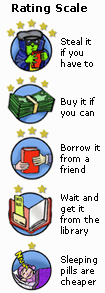|
|
Simplicity: The New Competitive Advantage in a World of More, Better, Faster
By Bill Jensen, Perseus Books, Cambridge Massachusetts, 2000
|
|
|
|
Simplicity: The New Competitive Advantage in a World of More, Better, Faster
By Bill Jensen, Perseus Books, Cambridge Massachusetts, 2000
|
|
  Are we all just deer in the headlights on the information highway? Sometimes it feels that way in the workplace. And who, or what, pray tell, is in the driver's seat of the vehicle bearing down on us? Bill Jensen might say it's "complexity," the seemingly overwhelming amount of confusion that stands between us and our ability to get work done. Jensen says we generally know what needs to be done, but complexity keeps us from figuring out how to do it. Are we all just deer in the headlights on the information highway? Sometimes it feels that way in the workplace. And who, or what, pray tell, is in the driver's seat of the vehicle bearing down on us? Bill Jensen might say it's "complexity," the seemingly overwhelming amount of confusion that stands between us and our ability to get work done. Jensen says we generally know what needs to be done, but complexity keeps us from figuring out how to do it.Jensen's top four nominees for sources of complexity are:
Put otherwise, "Dirty Little Secret, Hidden in Plain Sight: Work complexity is the result of our worst intellectual habits. We're not structuring goals, communication, information, and knowledge so that a diverse workforce can use them to make decisions." (p. 21) And why does it matter? According to Jensen, making the right decisions quickly is now the competitive edge that makes the difference between both individual and corporate success or failure. With the amount of business information doubling every 1,100 days (p. 23), organizations need to assure that employees have information in a readily usable form. And for the same reason, the brightest and best employees will gravitate to the organizations that use their time and talents well--and will shun the ones that don't. Jensen proceeds to describe how both individuals and organizations can behave differently in order to work productively despite complexity. For individuals, the key is learning to use time differently; for organizations, it's working backwards from what people need to design infrastructure that allows them to make good, fast decisions. I thought I'd test drive some of Jensen's suggestions at work to see if they made a difference in real life (which is how, in my better moments, I like to think of my life). I posted on my whiteboard a list of five questions Jensen advises an individual to ask when giving or receiving an assignment. Those questions were:
The first thing I noticed is that I have typically been thinking along these lines for some time when giving and receiving assignments. The second thing I noticed was that having the questions right in front of me helped me focus more quickly on the information needed. And third, I noticed that using the questions was very helpful. While it was gratifying to see that much of what I've already been doing both matched Jensen's advice and was effective, I wondered what was really "new" about this "competitive advantage." Then I began to realize: the processes aren't new; what's new is that they are now recognized as a source of competitive advantage in the face of overwhelming amounts of info! Aha! On the organizational side, my test drive has taken a different form. In meetings, I've paid more attention to observing and asking if the decisions being made will actually meet the needs of employees in their daily work. It's surprising how often this question either went unanswered or caused a rethinking of decisions. Jensen contends that organizations typically fail to design systems that account for human nature and the ways employees really go about making decisions, and that this failure generates a lack of productivity and trust on the part of employees. "...although people tolerate management's logic, they will always act on their own conclusions." (p. 30) Okay. My test drive of a couple of Jensen's ideas indicates to me that they are fairly simple (hmmmmm!) if not always easy, and can be useful, even if they're not brand new. To his credit, Jensen admits, "Nothing here is brain surgery. Just really hard work. Every day." (p. 26) Currently, and for the foreseeable future, lots of folks will be attempting to make money by selling books that offer "the answer" to improving the world of work. Is this one worth the read? The tools and examples Jensen includes in the book could be useful to any newcomer or old-timer in the workforce, to any employee or manager who believes that achieving clarity provides a workplace advantage. It's a pretty accessible read and offers some tactics an individual can put to work immediately. Buy it if you can afford it. [No deer were killed in the writing of this review; hopefully none are suffering from its reading.]
About Bill Jensen
Information architect with over 20 years experience in change and consulting. His new book, Simplicity: The New Competitive Advantage in a World of More, Better, Faster, has been heralded as a "breakthrough in the design of understanding," and an "outline for the future of leadership." He holds degrees in Communication Design and Organizational Development. While his work is important, he tries to never take himself too seriously. Personal life fantasy: Bicycling around the globe via breweries.
|
|
|